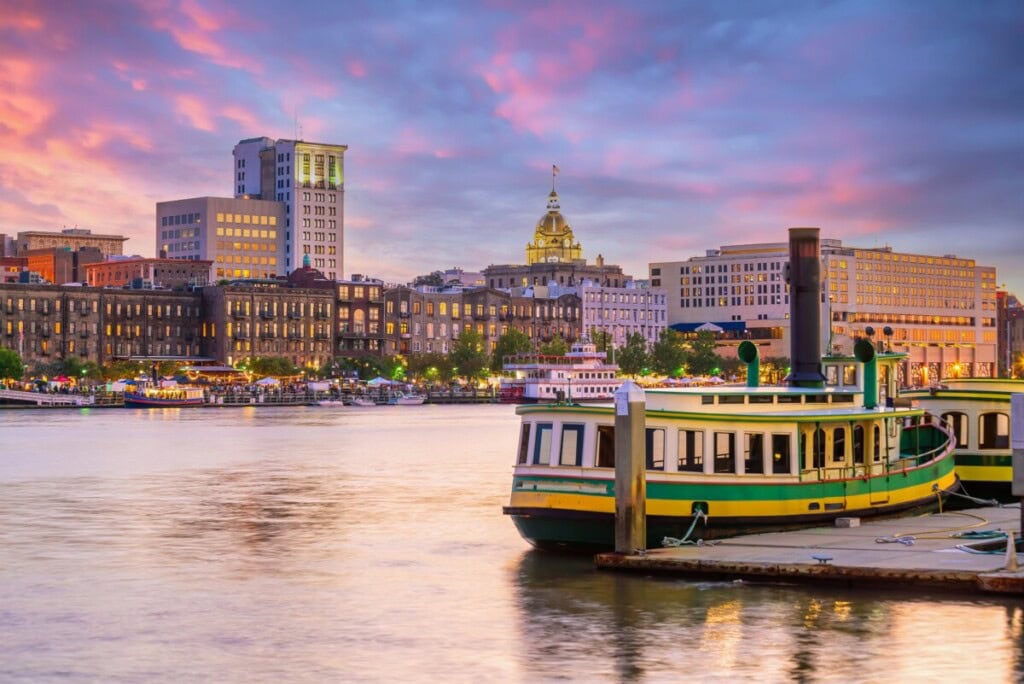Charleston vs Savannah: Which City is Right for You? Comparing Real Estate, Cost of Living, Culture, and More

You might be thinking about settling in a house in Charleston or an apartment in Savannah, two Southern gems known for their charm, history, and warm weather. Charleston offers a great culinary scene and coastal living, while Savannah provides affordable housing with its laid-back Southern charm. Whether you’re attracted to Charleston’s waterfront views or Savannah’s cobblestone squares, picking the right city can be challenging.
From real estate and affordability to lifestyle and culture, we’ll break down the differences in this article to help you decide which city fits your needs best.
Housing in Charleston vs Savannah
Charleston and Savannah each provide unique housing markets filled with historic charm and Southern beauty. Let’s dive into the differences in housing costs, styles, and options between these two cities.
Housing in Charleston
Charleston is known for its beautifully preserved historic homes, from grand antebellum mansions in South of Broad to quaint cottages in the French Quarter. The city offers a picturesque living environment, with many properties featuring classic Southern architecture and access to nearby beaches. Charleston’s growing popularity has led to higher home prices, particularly in prime locations close to the city center or along the water. While housing can be expensive, there are still affordable options in surrounding areas like North Charleston.
Median home cost: The median home sale price in Charleston is around $601,675, with some of the more desirable areas commanding higher prices.
Average rental cost: The average rent in Charleston is about $1,468 per month, with prices depending on proximity to downtown and the coast.
Housing in Savannah
Savannah’s real estate market offers a more affordable range of options compared to Charleston, with plenty of historic homes and newer developments. From the iconic squares and cobblestone streets of the Historic District to the quiet Savannah neighborhoods of Ardsley Park, Savannah provides a mix of Southern charm and affordable living. Homes in Savannah tend to be less expensive, especially for those willing to look outside of downtown, where larger lots and more space are available.
Median home cost: The median home sale price in Savannah is around $342,000, making it a more budget-friendly alternative to Charleston.
Average rental cost: The average rent in Savannah is approximately $1,633 per month.
Cost of living in Charleston vs Savannah
The cost of living in Charleston is about 7% higher than in Savannah, with housing and lifestyle expenses being the primary factors that contribute to this difference.
1. Utilities
Utilities in Charleston are approximately 22% higher than in Savannah. The coastal climate in Charleston, with its hot summers and reliance on air conditioning, leads to higher electricity usage and costs. Savannah’s slightly more moderate climate helps keep utility expenses lower in comparison, as there is less reliance on cooling systems.
2. Groceries
Groceries in Charleston are about 1% less expensive than in Savannah. Despite Charleston’s growing population and the demand for imported goods driving up prices, it still manages to offer slightly more affordable grocery costs than Savannah, where prices can be higher due to regional supply and demand factors.
3. Transportation
Transportation costs in Charleston are 9% lower than in Savannah. Although both cities are largely car-dependent, Charleston’s developing infrastructure and limited public transit make transportation slightly more manageable and affordable than in Savannah, where options for getting around may be more limited and costly.
4. Healthcare
Healthcare in Charleston is about 28% less expensive than in Savannah. Charleston benefits from a variety of specialized medical facilities that drive up the overall cost of services, but Savannah, while offering quality healthcare, tends to have lower costs for routine services.
5. Lifestyle
Lifestyle expenses in Charleston are about 2% higher than in Savannah. Charleston’s focus on tourism, upscale dining, and shopping makes leisure activities slightly more expensive than in Savannah, where a more relaxed, budget-friendly lifestyle is the norm.
Charleston vs Savannah in size and population: Two Southern charmers
Charleston and Savannah, both known for their Southern charm and rich history, vary in size and population. Charleston covers around 127 square miles with a population of about 150,000, offering a spread-out coastal feel. Savannah, slightly smaller, spans roughly 108 square miles with a population of around 148,000, creating a similar small-city atmosphere. Both cities maintain a laid-back, picturesque vibe, but Charleston’s larger size gives it more of a coastal sprawl, while Savannah’s grid-like historic layout provides a cozy, walkable experience.
Weather and climate in Charleston vs Savannah
Charleston’s climate and Savannah’s climate share a similar subtropical weather, known for hot, humid summers and mild winters. Both cities enjoy long, warm seasons, with temperatures regularly climbing into the 90s in the summer, but Charleston’s coastal location makes it slightly more prone to tropical storms and hurricanes. Savannah, also coastal, faces similar risks but tends to experience fewer direct hits from hurricanes. Winters are mild in both cities, with Charleston experiencing slightly cooler temperatures due to its more northern location, while Savannah enjoys warmer, more temperate winters.
The Job market in Charleston vs Savannah
Charleston: A growing tech and aerospace sector
Charleston’s job market is expanding, driven by sectors such as technology, aerospace, and tourism. The city has seen a rise in tech startups and a significant aerospace presence, with Boeing being one of the region’s largest employers. Charleston’s employment rate sits around 67%, with a median household income of approximately $95,000 and an average hourly wage of $28.29. Healthcare and manufacturing are also significant contributors to the job market, offering a range of opportunities. With its booming tourism industry, hospitality also plays a major role, providing seasonal and permanent employment for many residents.
Savannah: Tourism, manufacturing, and logistics hub
Savannah’s job market is largely influenced by tourism, manufacturing, and its vital logistics industry due to its major seaport. With an employment rate of about 60% and a median household income of $57,000, Savannah offers lower wages compared to Charleston, with an average hourly wage of $26.92. However, the cost of living is more affordable. Key employers include Gulfstream Aerospace in the manufacturing sector and the Port of Savannah, one of the busiest ports in the U.S., which drives a robust logistics industry. The tourism industry also contributes significantly to Savannah’s economy, attracting workers in hospitality, retail, and services.
Transportation in Charleston vs Savannah
Charleston: Car-dependent with growing transit options
Charleston remains largely car-dependent, with limited public transportation available through CARTA (Charleston Area Regional Transportation Authority). However, the city is making strides in expanding its bus and shuttle services. Biking is becoming more popular, especially in downtown Charleston, where the historic layout and narrow streets create a more walkable environment.
Walk Score: 40
Bike Score: 50
Transit Score: 24
Savannah: Car-friendly with walkable historic district
Savannah is also a car-dependent city, though its Historic District is highly walkable, making it easy to explore on foot. The Chatham Area Transit (CAT) provides bus services throughout the city, though the transit system is limited compared to larger cities. Biking is increasing in popularity, particularly along the scenic areas near the waterfront.
Walk Score: 44
Bike Score: 52
Travel in and out of Charleston vs Savannah
Both cities have international airports and access to regional travel, but their transportation hubs are smaller compared to larger metropolitan areas.
Charleston: Charleston International Airport, Greyhound, and Amtrak’s Palmetto route.
Savannah: Savannah/Hilton Head International Airport, Amtrak’s Silver Star route, Greyhound, and regional CAT buses.
Lifestyle and things to do in Charleston and Savannah
A day in the life of a Charlestonian
Living in Charleston is all about coastal charm, historic elegance, and Southern hospitality. Mornings in Charleston often start with a cup of coffee while overlooking the harbor, followed by a leisurely stroll through the historic streets, lined with colorful houses and cobblestone alleys. Weekends are perfect for enjoying the city’s renowned food scene, with fresh seafood at local eateries or exploring farmers’ markets. Outdoor activities are a big part of life here, with residents enjoying kayaking, boating, and relaxing on nearby beaches like Sullivan’s Island or Folly Beach. Charleston’s rich history and laid-back pace make it a charming place to call home.
Top things to do in Charleston:
Tour historic homes and plantations, such as Magnolia Plantation and Gardens
Visit the South Carolina Aquarium
Explore the Charleston City Market
Take a boat tour of Charleston Harbor
Enjoy seafood at Shem Creek
Google Street View of the Charleston City Market
Charleston parks and green spaces:
Stroll through Waterfront Park
Relax at White Point Garden
Visit Hampton Park for picnicking
Walk along the Arthur Ravenel Jr. Bridge
Kayak through Shem Creek
Google Street View of White Point Garden
Charleston tourist attractions:
Historic Downtown Charleston
Fort Sumter
The Battery
Rainbow Row
Middleton Place
A day in the life of a Savannahian
Savannah’s slower pace and historic charm make it a delightful city to live in. Mornings often start with a walk through Forsyth Park or along the picturesque squares, surrounded by oak trees draped in Spanish moss. The city’s rich history can be felt in every corner, from the beautifully preserved historic homes to the vibrant arts scene. Weekends are perfect for enjoying Savannah’s incredible food scene, including famous Southern cuisine and outdoor dining along the riverfront. Residents also take advantage of the nearby beaches on Tybee Island for a relaxing day by the water.
Top things to do in Savannah:
Tour the historic district and explore Savannah’s famous squares
Visit the Telfair Museums and the Owens-Thomas House
Take a ghost tour of the city’s haunted sites
Enjoy a riverboat cruise along the Savannah River
Explore the Bonaventure Cemetery
Google Street View of the Bonaventure Cemetery
Savannah parks and green spaces:
Relax in Forsyth Park
Walk through the historic squares, like Chippewa and Lafayette Square
Picnic at Wormsloe Historic Site
Stroll along the Savannah Riverwalk
Visit Skidaway Island State Park
Google Street View of the Savannah Riverwalk
Savannah tourist attractions:
Forsyth Park
River Street
Bonaventure Cemetery
Tybee Island
The Cathedral of St. John the Baptist
Food and culture in Charleston vs Savannah
Charleston: A coastal culinary delight
Charleston is known for its Lowcountry cuisine, with seafood playing a central role in dishes like shrimp and grits and she-crab soup. The city’s food scene offers a mix of traditional Southern comfort food and innovative dining experiences, with farm-to-table restaurants and fresh, local ingredients. The annual Charleston Wine + Food Festival celebrates the city’s culinary talent, attracting foodies from around the country. Charleston is also rich in culture, with its well-preserved architecture and historic charm. The city’s vibrant arts scene includes galleries, music venues, and theater performances, adding to Charleston’s allure as a cultural hub of the South.
Savannah: Southern charm on a plate
Savannah’s food culture is steeped in Southern traditions, with dishes like fried green tomatoes, collard greens, and pecan pie taking center stage. The city’s culinary scene combines classic Southern comfort with modern influences, offering a wide range of dining options, from historic restaurants in the heart of the city to cozy cafes along the riverfront. The annual Savannah Food and Wine Festival showcases the city’s vibrant food culture. Savannah is equally rich in arts and culture, with its historic squares, beautiful mansions, and lively art scene. The city’s art galleries, music venues, and historic theaters reflect its deep cultural heritage and love for the arts.
Charleston vs Savannah sports scene
Charleston: A growing sports hub
Charleston’s sports scene is growing, with the city hosting a mix of professional and collegiate teams. The Charleston Battery, a professional soccer team, is a local favorite, while the South Carolina Stingrays, a minor league hockey team, adds excitement for hockey fans. College sports, particularly football, are a big draw in the area, with fans supporting teams from nearby universities. While Charleston doesn’t have the major professional leagues seen in larger cities, its growing sports culture is gaining momentum, and the city’s love for outdoor activities, from boating to golf, adds to the active lifestyle.
Savannah: A focus on local and collegiate sports
Savannah’s sports scene centers around local and collegiate athletics. The Savannah Bananas, a collegiate summer baseball team, are a fan favorite, known for their unique and entertaining approach to the game. College football also has a strong following, with fans supporting teams from nearby universities. Savannah’s sporting culture may not be as vast as larger cities, but its charm lies in the local teams and the community events surrounding them. Outdoor activities, including golf and boating, are also popular, reflecting the city’s love for an active lifestyle.
The post Charleston vs Savannah: Which City is Right for You? Comparing Real Estate, Cost of Living, Culture, and More appeared first on Redfin | Real Estate Tips for Home Buying, Selling & More.




